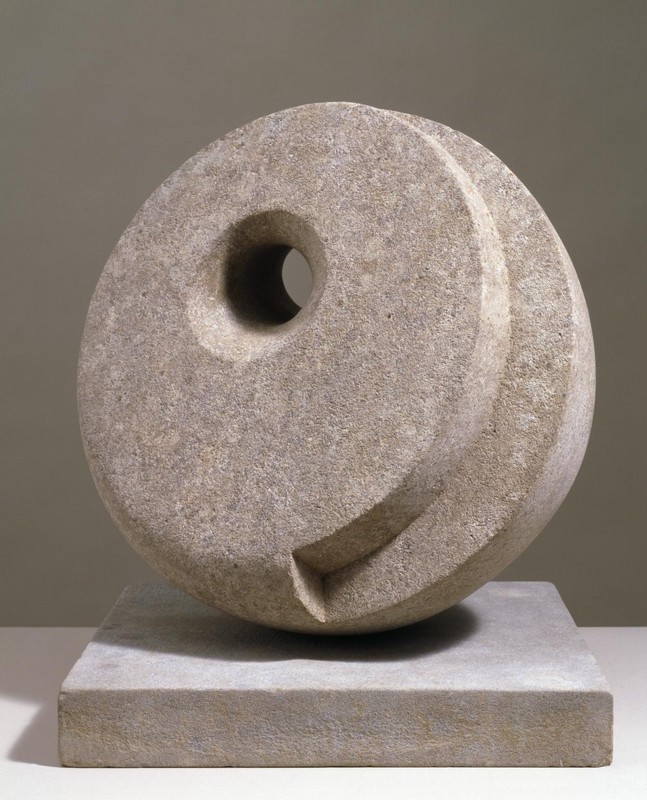Around Abstract Art 1920–1935
07 Jan 2013 - 05 Oct 2015

Dame Barbara Hepworth
Pierced Hemisphere II 1937-8
Hoptonwood stone on Portland stone base
object: 435 x 380 x 380 mm, 50 kg
Accepted by HM Government in lieu of inheritance tax and allocated to Tate 2004© Bowness, Hepworth Estate
Pierced Hemisphere II 1937-8
Hoptonwood stone on Portland stone base
object: 435 x 380 x 380 mm, 50 kg
Accepted by HM Government in lieu of inheritance tax and allocated to Tate 2004© Bowness, Hepworth Estate
In the period between the two world wars, artists developed new forms of abstract art based on aesthetic idealism and the vision of a more perfect society.
In 1937, Piet Mondrian wrote of two threads in contemporary art: ‘the aesthetic expression of oneself’ and ‘the direct creation of universal beauty’. The contrast is telling. Living in an era defined by the chaos of revolution and war, Mondrian and others stepped away from individualism and appealed to the harmonious relationships rooted in the laws of geometry. These structures appealed to many artists and architects as ideal forms fit for a new world. Naum Gabo, who had direct experience of the Russian Revolution, asserted that the ‘material destruction’ of the era ‘cannot deprive us of our optimism ... since we see that in the realm of ideas we are now entering the period of reconstruction.’
Developments in engineering and architecture helped to shape this new artistic vision. Sculptors turned from modelling or carving to assembling and constructing in order to delineate space. Painters replaced the drama of colour and brushwork with measured restraint and uniformity. White came to predominate for its perceived purity and clarity, which chimed with the interiors and structures of the new International Style architecture of Le Corbusier, Walter Gropius and others. Of course, the variety of artistic practice also encompassed very different styles, such as the rich colour harmonies of Wassily Kandinsky, and the sensuous carvings of Barbara Hepworth.
The question of what to call this new approach to art remained problematic. Russian artists used the term ‘constructivism’. Theo van Doesburg suggested a distinction between ‘abstract’ art, whose starting point was a recognisable image which was progressively abstracted, and ‘concrete’ art, which stemmed solely from the mind of the artist or the process of making. When many key figures came to Britain in exile in the late 1930s, they favoured ‘constructive art’ as a broader definition. None of these terms entirely displaced ‘abstract’.
Curated by Matthew Gale
In 1937, Piet Mondrian wrote of two threads in contemporary art: ‘the aesthetic expression of oneself’ and ‘the direct creation of universal beauty’. The contrast is telling. Living in an era defined by the chaos of revolution and war, Mondrian and others stepped away from individualism and appealed to the harmonious relationships rooted in the laws of geometry. These structures appealed to many artists and architects as ideal forms fit for a new world. Naum Gabo, who had direct experience of the Russian Revolution, asserted that the ‘material destruction’ of the era ‘cannot deprive us of our optimism ... since we see that in the realm of ideas we are now entering the period of reconstruction.’
Developments in engineering and architecture helped to shape this new artistic vision. Sculptors turned from modelling or carving to assembling and constructing in order to delineate space. Painters replaced the drama of colour and brushwork with measured restraint and uniformity. White came to predominate for its perceived purity and clarity, which chimed with the interiors and structures of the new International Style architecture of Le Corbusier, Walter Gropius and others. Of course, the variety of artistic practice also encompassed very different styles, such as the rich colour harmonies of Wassily Kandinsky, and the sensuous carvings of Barbara Hepworth.
The question of what to call this new approach to art remained problematic. Russian artists used the term ‘constructivism’. Theo van Doesburg suggested a distinction between ‘abstract’ art, whose starting point was a recognisable image which was progressively abstracted, and ‘concrete’ art, which stemmed solely from the mind of the artist or the process of making. When many key figures came to Britain in exile in the late 1930s, they favoured ‘constructive art’ as a broader definition. None of these terms entirely displaced ‘abstract’.
Curated by Matthew Gale
